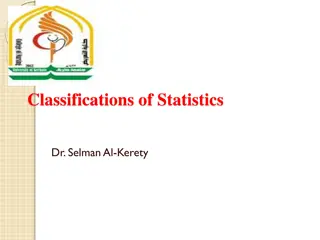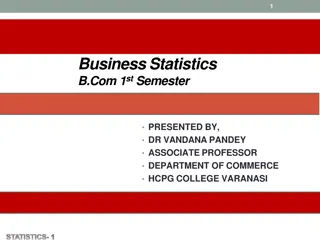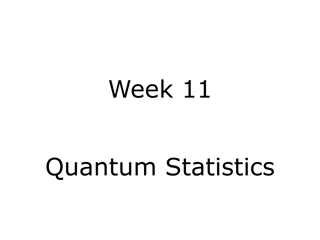
Understanding Business Statistics for Effective Decision Making
Explore the world of statistics and its importance in decision-making processes. From descriptive to inferential statistics, learn about key concepts, characteristics, and applications of statistics in various fields. Discover how statistics help in gathering and analyzing data to make informed decisions based on facts and figures.
Download Presentation

Please find below an Image/Link to download the presentation.
The content on the website is provided AS IS for your information and personal use only. It may not be sold, licensed, or shared on other websites without obtaining consent from the author. If you encounter any issues during the download, it is possible that the publisher has removed the file from their server.
You are allowed to download the files provided on this website for personal or commercial use, subject to the condition that they are used lawfully. All files are the property of their respective owners.
The content on the website is provided AS IS for your information and personal use only. It may not be sold, licensed, or shared on other websites without obtaining consent from the author.
E N D
Presentation Transcript
BUSINESS STATISTICS FOR MANAGEMENT
STATISTICS DEFINITION: Statistics is a branch that deals with every aspect of the data. Statistical knowledge helps to choose the proper method of collecting the data and employ those samples in the correct analysis process in order to effectively produce the results. In short, statistics is a crucial process which helps to make the decision based on the data.
The word 'Statistics' is used in both its singular as well as its plural senses. In the singular sense, statistics may be defined as the science of collection, presentation, analysis and interpretation of numerical data. In the plural sense, statistics means numerical facts or observation collected with a definite purpose.
TYPES OF STATISTICS The two main branches of statistics are: Descriptive Statistics Inferential Statistics
Descriptive Statistics Through graphs or tables, or numerical calculations, descriptive statistics uses the data to provide descriptions of the population. Inferential Statistics Based on the data sample taken from the population, inferential statistics makes the predictions and inferences. Both types of statistics are equally employed in the field of statistical analysis.
CHARACTERISTICS OF STATISTICS The important characteristics of Statistics are as follows: Statistics are numerically expressed. It has an aggregate of facts. Data are collected in systematic order. It should be comparable to each other. Data are collected for a planned purpose.
IMPORTANCE OF STATISTICS Statistics helps in gathering information about the appropriate quantitative data. It depicts the complex data in graphical form,tabular form and in diagrammatic representation to understand it easily. It provides the exact description and a better understanding. It helps in designing the effective and proper planning of the statistical inquiry in any field. It gives valid inferences with the reliability measures about the population parameters from the sample data. It helps to understand the variability pattern through the quantitative observations
LIMITATIONS OF STATISTICS Some of the limitations of statistics are as follows: Statistics Suits to the Study of Quantitative Data Only Statistical Results are not Exact Statistics Deals with Aggregates Only Statistics is Useful for Experts Only Statistics does not Provide Solutions to the Problems






















